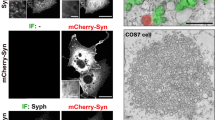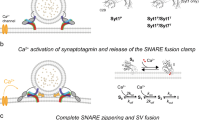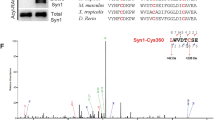Abstract
Synapsins, a family of synaptic vesicle proteins, have been shown to regulate neurotransmitter release; the mechanism(s) by which they act are not fully understood. Here we have studied the role of domain E of synapsins in neurotransmitter release at the squid giant synapse. Two squid synapsin isoforms were cloned and found to contain a carboxy (C)-terminal domain homologous to domain E of the vertebrate a-type synapsin isoforms. Presynaptic injection of a peptide fragment of domain E greatly reduced the number of synaptic vesicles in the periphery of the active zone, and increased the rate and extent of synaptic depression, suggesting that domain E is essential for synapsins to regulate a reserve pool of synaptic vesicles. Domain E peptide had no effect on the number of docked synaptic vesicles, yet reversibly inhibited and slowed the kinetics of neurotransmitter release, indicating a second role for synapsins that is more intimately associated with the release process itself. Thus, synapsin domain E is involved in at least two distinct reactions that are crucial for exocytosis in presynaptic terminals.
This is a preview of subscription content, access via your institution
Access options
Subscribe to this journal
Receive 12 print issues and online access
$209.00 per year
only $17.42 per issue
Buy this article
- Purchase on Springer Link
- Instant access to full article PDF
Prices may be subject to local taxes which are calculated during checkout





Similar content being viewed by others
References
Rothman, J.E. Mechanisms of intracellular protein transport. Nature 372, 55–63 (1994)
Südhof, T. C. The synaptic vesicle cycle: a cascade of protein-protein interactions. Nature 375, 645–653 (1995)
Scheller, R.H. Membrane trafficking in the presynaptic nerve terminal. Neuron 14, 894–897 (1995)
Augustine, G. J., Burns, M. E., DeBello, W. M., Pettit, D. L. & Schweizer, F. E. Exocytosis: proteins and perturbations . Ann. Rev. Pharmacol. Toxicol. 36, 659– 701 (1996)
Greengard, P., Valtorta, F., Czernik, A. J. & Benfenati, F. Synaptic vesicle phosphoproteins and regulation of synaptic function. Science 259, 780–785 (1993)
Südhof et al. Synapsins: mosaics of shared and individual domains in a family of synaptic vesicle phosphoproteins . Science 245, 1474–1480 (1989)
Kao, H.-T. et al. A third member of the synapsin gene family. Proc. Natl. Acad. Sci. USA 95, 4667–4672 (1998)
Klagges, B. R. et al. Invertebrate synapsins: a single gene codes for several isoforms in Drosophila. J. Neurosci. 16, 3154–3165 (1996)
Pieribone, V. A. et al. Distinct pools of synaptic vesicles in neurotransmitter release. Nature 375, 493–497 (1995)
Rosahl, T. W. et al. Essential functions of synapsins I and II in synaptic vesicle regulation. Nature 375, 488–493 (1995)
Rosahl, T. W. et al. Short-term synaptic plasticity is altered in mice lacking synapsin I. Cell 75, 661–670 (1993)
Li, L. et al. Impairment of synaptic vesicle clustering and of synaptic transmission, and increased seizure propensity, in synapsin I-deficient mice. Proc. Natl. Acad. Sci. USA 92, 9235–9239 (1995)
Takei, Y. et al. Synapsin I deficiency results in the structural change in the presynaptic terminals in the murine nervous system. J. Cell Biol. 131, 1789–1800 (1995)
Ryan, T. A., Li, L., Chin, L.-S., Greengard, P. & Smith, S. J. Synaptic vesicle recycling in synapsin I knock-out mice. J. Cell Biol. 134, 1219– 1227 (1996)
Llinás, R., McGuinness, T. L., Leonard, C. S., Sugimori, M. & Greengard, P. Intraterminal injection of synapsin I or calcium/calmodulin-dependent protein kinase II alters neurotransmitter release at the squid giant synapse. Proc. Natl. Acad. Sci. USA 82, 3035–3039 (1985)
Llinás, R. Gruner, J. A., Sugimori, M., McGuinness, T. L. & Greengard, P. Regulation by synapsin I and Ca(2+)-calmodulin-dependent protein kinase II of the transmitter release in squid giant synapse. J. Physiol. 436, 257–282 (1991)
Lin, J. W., Sugimori, M., Llinás, R. R., McGuinness, T. L. & Greengard, P. Effects of synapsin I and calcium/calmodulin-dependent protein kinase II on spontaneous neurotransmitter release in the squid giant synapse. Proc. Natl. Acad. Sci. USA 87, 8257–8261 (1990)
Hackett, J. T., Cochran, S. L., Greenfield, J. Jr., Brosius, D. C. & Ueda, T. Synapsin I injected presynaptically into goldfish mauthner axons reduces quantal synaptic transmission . J. Neurophysiol. 63, 701– 706 (1990)
Towbin, L., Staehelin, T. & Gordon, T. Electrophoretic transfer of proteins from polyacrylamide gels to nitrocellulose sheets: procedure and some applications. Proc. Natl. Acad. Sci. USA 76, 4350–4354 (1979)
Bommert, K. et al. Inhibition of neurotransmitter release by C2-domain peptides implicates synaptotagmin in exocytosis. Nature 363, 163– 165 (1993)
Burns, M. E., Sasaki, T., Takai, Y. and Augustine, G.J. Rabphilin-3A: a multifunctional regulator of synaptic vesicle traffic. J. Gen. Physiol. 111, 243–255 (1998)
Kusano, K. & Landau, E. M. Depression and recovery of transmission at the squid giant synapse. J. Physiol. 245, 13–32 (1975)
Betz, W.J. Depression of transmitter release at the neuromuscular junction of the frog. J. Physiol. 206, 629–644 (1970)
Swandulla, D., Hans, M., Zipser, K. & Augustine, G.J. Role of residual calcium in synaptic depression and posttetanic potentiation: fast and slow calcium signaling in nerve terminals. Neuron 7, 915–926 (1991)
Charlton, M. P. & Bittner, G. D. Facilitation of transmitter release at squid synapses. J. Gen. Physiol. 72, 471–486 (1978)
Zucker, R.S. Exocytosis: a molecular and physiological perspective. Neuron 17 , 1049–1055 (1996)
Heuser, J. E. & Reese, T. S. Evidence for recycling of synaptic vesicle membrane during transmitter release at the frog neuromuscular junction . J. Cell Biol. 57, 315– 344 (1973)
Takei, K., Mundigl, O., Daniell, L. & De Camilli, P. The synaptic vesicle cycle: a single vesicle budding step involving clathrin and dynamin . J. Cell Biol. 133, 1237– 1250 (1996)
Schweizer, F. E., Betz, H. & Augustine, G. J. From vesicle docking to endocytosis: intermediate reactions of exocytosis. Neuron 14, 689– 696 (1995)
Parsons, T. D., Coorssen, J. R., Horstmann, H. & Almers, W. Docked granules, the exocytotic burst, and the need for ATP hydrolysis in endocrine cells. Neuron 15, 1085– 1096 (1995)
Schikorski, T. & Stevens, C. F. Quantitative ultrastructural analysis of hippocampal excitatory synapses. J. Neurosci. 17 , 5858–5867 (1997)
Hunt, J. M. et al. A post-docking role for synaptobrevin in synaptic vesicle fusion. Neuron 12, 1269–1279 (1994)
Hess, S. D., Doroshenko, P. A. & Augustine, G. J. A functional role for GTP-binding proteins in synaptic vesicle cycling. Science 259, 1169– 1172 (1993)
DeBello, W. M. et al. SNAP-mediated protein-protein interactions essential for neurotransmitter release. Nature 373, 626–630 (1995)
Schweizer, F. E. et al. Regulation of neurotransmitter release kinetics by NSF. Science , 279, 1203–1206 (1998)
O'Connor, V. et al. Disruption of syntaxin-mediated protein interactions blocks neurotransmitter secretion . Proc. Natl. Acad. Sci. USA 94, 12186– 12191 (1997)
Hay, J. C. and Scheller, R. H. SNAREs and NSF in targeted membrane fusion. Curr. Opin. Cell Biol. 9, 505– 512 (1997)
Söllner, T., Bennett, M. K., Whiteheart, S. W., Scheller, R. H. & Rothman, J. E. A protein assembly-disassembly pathway in vitro that may correspond to sequential steps of synaptic vesicle docking, activation and fusion. Cell 75, 409–418 (1993)
Hirokawa, N., Sobue, K., Kanda, K., Harada, A. & Yorifuji, H. The cytoskeletal architecture of the presynaptic terminal and molecular structure of synapsin 1. J. Cell Biol. 108, 111–126 (1989)
Valtorta, F. et al. Localization of synapsin I at the frog neuromuscular junction. Neurosci. 24, 593–603 (1988)
Torri-Tarelli, F. et al. Redistribution of synaptophysin and synapsin I during α-latrotoxin-induced release of neurotransmitter at the neuromuscular junction. J. Cell Biol. 110, 449–459 (1990)
Rahamimoff, R. and Fernandez, J. M. Pre- and postfusion regulation of transmitter release. Neuron 18, 17– 27 (1997)
Vogel, S. S., Blank, P. S. and Zimmerberg, J. Poisson-distributed active fusion complexes underlie the control of the rate and extent of exocytosis by calcium. J. Cell Biol. 134, 329–338 (1996)
Hong, R. M. et al. Association of N-ethylmaleimide-sensitive factor with synaptic vesicles. FEBS Lett. 350, 253–257 (1994)
Esser, L. et al. Synapsin I is structurally similar to ATP-utilizing enzymes. EMBO J. 17, 977–984 (1998)
Hosaka, M. & Südhof, T. Synapsins I and II are ATP-binding proteins with differential Ca regulation. J. Biol. Chem. 273, 1425–1429 (1998)
Sanchez, M. E., Nuno, C. M., Buchanan, J. & Augustine, G.J. Contractions of the squid stellate ganglion. J. Exp. Biol. 152, 369–387 (1990)
Acknowledgements
We thank A. Jeromin and J. Battey for providing the squid stellate ganglion library, E. Buchner for providing the monoclonal antibody against Drosophila synapsin, S. Huber for EM image analysis, and J. Crawford for peptide synthesis. We are grateful to R. Rottenfusser (Zeiss), P. Bent (Nikon), and M. Delay (Axon Instruments) for loan of equipment and technical support. We also thank B. Finch and E. Griggs for help with the artwork, and V. Pieribone, T. Ryan and L. Brodin for advice and critical reading of the manuscript. Supported by a Grass Fellowship to S.H., The National Alliance for Research in Schizophrenia and Affective Disorders and The New York Community Trust by DeWitt-Wallace to H.-T. K., and NIH grants to P.G. and G.J.A.
Author information
Authors and Affiliations
Corresponding author
Rights and permissions
About this article
Cite this article
Hilfiker, S., Schweizer, F., Kao, HT. et al. Two sites of action for synapsin domain E in regulating neurotransmitter release. Nat Neurosci 1, 29–35 (1998). https://doi.org/10.1038/229
Received:
Accepted:
Published:
Issue Date:
DOI: https://doi.org/10.1038/229
This article is cited by
-
Synaptic retrograde regulation of the PKA-induced SNAP-25 and Synapsin-1 phosphorylation
Cellular & Molecular Biology Letters (2023)
-
Synapsin condensation controls synaptic vesicle sequestering and dynamics
Nature Communications (2023)
-
Function of Drosophila Synaptotagmins in membrane trafficking at synapses
Cellular and Molecular Life Sciences (2021)
-
Synapsins are expressed at neuronal and non-neuronal locations in Octopus vulgaris
Scientific Reports (2019)
-
The presynaptic machinery at the synapse of C. elegans
Invertebrate Neuroscience (2018)



